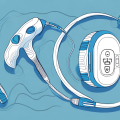If you’re someone who’s been suffering from sore or painful muscles, you’ve likely heard about foam rollers. But did you know that using a vibrating foam roller can be even more effective for relieving pain and discomfort? In this article, we’ll dive deep into the science behind this tool, its benefits, techniques for effective use, and more.
Understanding the Science Behind Foam Rolling
Before we dive into the specifics of vibrating foam rollers, let’s take a quick look at the science behind foam rolling in general. Foam rolling is a self-myofascial release technique, which means it helps to release tightness and tension in muscles and connective tissue. When you use a foam roller, the pressure you apply helps to break up adhesions and knots that have developed in your muscles, which in turn can lead to better mobility, flexibility, and pain relief.
Additionally, foam rolling has been shown to increase blood flow to the muscles, which can help to speed up recovery time after a workout. This increased blood flow also helps to deliver more oxygen and nutrients to the muscles, which can improve their overall health and function. Foam rolling has also been found to reduce inflammation in the body, which can be beneficial for those with chronic pain or inflammatory conditions. Overall, incorporating foam rolling into your fitness routine can have numerous benefits for your physical health and well-being.
What is a Vibrating Foam Roller – Types and Features
A vibrating foam roller is just like a regular foam roller, but with the added benefit of vibration. These rollers typically have a motor embedded in them that sends out high-frequency vibrations as you roll over them. There are various types of vibrating foam rollers available, from handheld ones to full-length ones that resemble traditional foam rollers. Some models come with additional features like adjustable vibration intensity or different surface textures.
Using a vibrating foam roller can provide additional benefits compared to a regular foam roller. The vibrations can help to increase blood flow and loosen up tight muscles more effectively. Additionally, some models come with rechargeable batteries, making them more convenient to use on-the-go. It’s important to note that vibrating foam rollers can be more expensive than traditional foam rollers, but the added benefits may be worth the investment for those looking to improve their muscle recovery and overall fitness.
Benefits of Using a Vibrating Foam Roller for Pain Relief
So, what are the benefits of using a vibrating foam roller compared to a regular foam roller? Firstly, the vibrations can help to further loosen up tight and tense muscles and increase blood flow, providing even more pain relief. Additionally, vibrating foam rollers can help to speed up recovery time after a workout by reducing inflammation and promoting better circulation. They can also target specific areas more effectively, making them a great tool for athletes or people with chronic pain conditions.
Moreover, using a vibrating foam roller can also improve flexibility and range of motion. The vibrations can help to break up scar tissue and adhesions, which can limit mobility and cause discomfort. By using a vibrating foam roller regularly, you can improve your overall flexibility and reduce the risk of injury during physical activity. Additionally, the vibrations can provide a relaxing massage-like sensation, which can help to reduce stress and promote relaxation.
Techniques for Effective Use of Vibrating Foam Rollers
To use a vibrating foam roller effectively, it’s important to develop a routine that works for you. Start by identifying which areas of your body are causing the most pain or discomfort, and focus on those areas first. Use slow, controlled movements to roll over those areas, taking care not to apply too much pressure or spend too long in any one spot. You may also want to incorporate static holds or gentle stretches into your routine to further release tension in your muscles.
It’s important to note that vibrating foam rollers are not suitable for everyone. If you have any medical conditions or injuries, it’s best to consult with a healthcare professional before incorporating a vibrating foam roller into your routine. Additionally, it’s important to use the foam roller correctly to avoid causing further injury or discomfort. Always start with a low intensity and gradually increase the intensity as your body becomes accustomed to the sensation. Remember to listen to your body and stop if you experience any pain or discomfort.
Targeted Muscle Groups for Pain Relief using Vibrating Foam Rollers
While vibrating foam rollers can be effective for relieving pain and tension throughout the body, certain muscle groups tend to benefit the most. These include the calves, quadriceps, hamstrings, glutes, and lower back. Try experimenting with different techniques for targeting these areas, such as hamstring curl-ups or glute bridges on the roller.
It’s important to note that vibrating foam rollers should be used in conjunction with other forms of pain relief, such as stretching and massage therapy. Additionally, it’s recommended to start with a lower intensity and gradually increase the vibration level as your muscles become more accustomed to the sensation. Always consult with a healthcare professional before incorporating new techniques into your pain management routine.
Tips for Beginners to Incorporate Vibrating Foam Rollers in their Workout Routine
If you’re new to foam rolling or vibrating foam rolling, it’s a good idea to start slowly and build up your routine over time. Begin with just a few minutes each day, focusing on one or two areas at a time, and gradually increase the duration and frequency of your sessions as your muscles adapt. Listen to your body and don’t push yourself too hard, especially if you’re experiencing pain or discomfort.
Precautions to Take While Using a Vibrating Foam Roller for Pain Relief
It’s important to exercise caution when using any kind of foam roller or massage tool, especially if you have pre-existing medical conditions or injuries. Always consult a healthcare professional before beginning a new treatment or exercise program, and avoid using a vibrating foam roller if you have any open wounds, deep vein thrombosis, or other serious medical concerns. In addition, be sure to properly clean your foam roller after each use to avoid spreading germs or bacteria.
Comparing Vibrating Foam Rollers with Other Pain-Relief Devices
While vibrating foam rollers are certainly effective for relieving pain and tension in muscles, they’re not the only tool out there for this purpose. Other effective pain-relief devices include massage balls, massage sticks, and percussion massagers. Each of these devices has its own unique benefits and drawbacks, so it’s worth exploring all of your options to find the best fit for your specific needs.
Expert Opinions and Studies on the Effectiveness of Vibrating Foam Rollers
Finally, it’s worth noting that there is a growing body of research supporting the use of vibrating foam rollers for pain relief and muscle recovery. For example, a study published in the International Journal of Sports Physical Therapy found that vibrating foam rollers were more effective than traditional foam rollers for reducing muscle soreness and improving flexibility. Other studies have found similar results, highlighting the potential benefits of this innovative tool.
Overall, if you’re looking for an effective and versatile way to relieve pain and tension in your muscles, a vibrating foam roller is definitely worth exploring. Keep these tips and techniques in mind as you begin to incorporate this tool into your routine, and don’t hesitate to consult with a healthcare professional if you have any concerns or questions along the way. With consistent use and a bit of patience, you may find that the benefits of vibrating foam rolling far exceed your expectations.





